The physicist Nassim Harmein, who dedicated his life from the age of nine to researching the basic geometry of space, and published an article on the Schwarzschild Proton, suggested a new perception of the relationship between physics and human consciousness.
One of the things Harmein pointed out was that space is the only thing in the world which connects everything, and we interact with space every moment of our lives.
Electrons and protons leave our cells, and return to them, constantly. Every exit transfers information from our cells to the surrounding space, and every entrance – from space to our cells.
Space itself is thus affected by the people and objects in it. All matter is made up of electrons and protons which vibrate and influence the energy field - colors, which are themselves a frequency, textures, and the way a certain space is designed.
In other words, space - here the working environment - is constantly defined by us and by the objects in it, and influences us in return – and so has a considerable effect on, and contribution to, the way of life and style of work of employees – their efficiency, creativity, and ability to problem-solve.
Designing a natural work environment, in line with the organization's strategy and goals, encourages teamwork, reduces conflict and intrigue, and increases the employees' investment and especially their ability to maintain standards of quality, efficiency and production in the long term – which effects the entire company, its profits and its branding.
Anthropologie
Clothing and lifestyle brand Anthropologie decided in 2006 to relocate its HQ. Owner and CEO Richard Hayne realized that in order to maximize the company's performance, he must relocate the main offices to a new compound which will enable a productive, appropriate and supportive work environment.
The company emphasized creating a work environment and culture which will shape clients' emotional connection with the brand, and strengthen employees' creativity. For a design and lifestyle brand, success depends on employees' creativity and innovation.
Their goal was to build a workshop-like space, enabling open discussion and mutual constructive criticism, which will allow imagination to flourish. They invested much thought in the space design, and results speak for themselves.
They build spacious and open offices, flooded by natural light, combined the old building, the old and pilling paint, with the colorful fabrics and textures which characterize their products - thus creating a stimulating and productive work environment enabling an imaginative and artistic dynamic.
Following the move, employee satisfaction increased, turnover rates decreased by 11%, and similarly so did the use of sick-days. Employees report that since the move they are happier coming to work. At the same time, ability to recruit new talent increased, and their head-hunting process shortened by 41%.
This is an example of designing a work environment in line with company strategy – in this case of creativity and informality – and which contributes to the brand, to the organizational culture, and to employees' style of work – an example of how a work environment is an important and inseparable part of company's resources in support of the human element.*
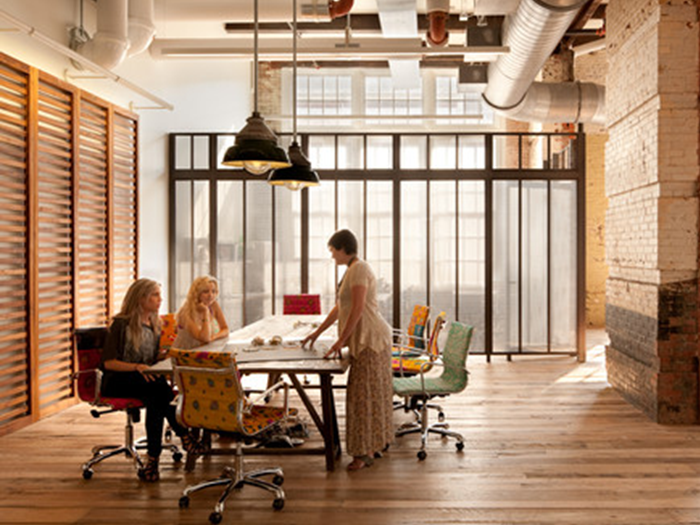
*from Merav Eichler's article in Mako.
What is a Work Environment?
When deciding on a location for offices or factories, the physical work environment is rarely taken into account, but it has a close connection with the cultural, ethical, structural, and legal message of the organization to its employees. It also affects employee productivity, creativity, and investment, and especially their ability to maintain quality and efficiency over time – all affecting the company's profit and brand.
Natural light, fresh air, cleanliness and order are undisputedly beneficial, even though they are absent from many offices, where air-conditioning and neon lights are the norm, and corners accumulate excess clutter. The resulting mess makes it harder for employees to find what they need, elongating search times and lowering productivity, efficiency, and concentration.
The physical environment is also affected by crowding, workstation setup, colors, scents, lighting, and other planning and design aspects which greatly influence employees temper, performance, alertness and vitality.

What is a Natural Work Environment?
When we go out to nature, our rate of breathing changes immediately, and a certain "something" is felt. Being outdoors connects us to our human nature. A natural work environment means a space which brings to the fore every employee's natural resources, while also supporting the organizations natural needs. Spending time in a natural work environment connects employees to their innate talents, and highlights the reasons you hired them.
The work environment needs to support the organization's strategy, culture and values. For that reason, when its design considers the physical and emotional conditions required by employees, the workplace becomes a "greenhouse" encouraging optimal expression, enjoyment and a smile every morning when coming into work, and at the end of the day. Work becomes a source of enjoyment and creativity for employees.
What's the Difference between a Regular workplace and One with a Natural Work Environment?
The design of a natural work environment has a completely different attitude than the familiar one. Normally, most managers and designers think only of the business's functional requirements. Size, number of workstations – maximal efficient use of space.
Designing a natural work environment starts with the assumption that everything around us influences us and that our work environment sends subliminal and sensory messages to the people working in it - and so takes into account the cultural and organizational messages a company wants to spread, and as importantly, the productivity it wants its employees to have, and includes this considerations when designing, and picking colors and materials.
A good example for how our environment affects behavior is seen in fast-food restaurants, compared with traditional restaurants that function also as recreational sites. In the former, colors are yellow or red. The environment is loud, sitting isn’t very comfortable, sometimes the tables look like toys – all of this to ensure we don't sit there too long, but eat quickly and leave.
Contrastingly, the latter have a deeper color palate, like dark-red, rust and dark brown wood instead of red and yellow. Lights will be dim, and the overall atmosphere designed to encourage long and comfortable stays, and to allow enjoyment of the meal. To experience textures and taste, notice the style of presentation, engage the senses.
In both cases the establishments are restaurants, but each has a different character, and so the way it's designed dictates a different behavior.
Similarly, a natural work environment affects behaviors, relationships, and leveraging human potential.
Tools for Designing a Natural Work Environment
In the above example we can see how a different design of a restaurant causes different behaviors, including what is considered an acceptable price for a meal. I'll not discuss here how digestion and health are affected by different meal styles, but I will discuss the tools which give each space a different potential.
These are design tools.
For example, colors can bring out the best in people, make them smile, increase motivation and creativity, and if necessary, also calm them and give a sense of breadth. It can create a young and fresh, or dark and gloomy, feeling.
A correct arrangement of furniture helps maintain alertness, concentration, cooperation, and good relations among employees.
Creating a maze with walls may be the most efficient way to use a work space, but creates complicated relationships, conflicts, lack of clarity and restlessness.
Clear and clean lines with well-defined directions of spaces, corridors and offices, create a sense of security and stability, and prevent feelings of uncertainty which infuse the workplace with tension and waste precious time as each person "finds their place", as well as curtailing intrigues among employees.
Material and textures can say a lot about an organization's culture. Metal furniture with sleek sharp lines will communicate a strictness, while natural-wood furniture will give a feeling of informality.
Natural light reduces fatigue and headaches, and encourages concentration and focus.
So, for example, a company whose focus is on growth should prefer open spaces, and a green color palate which will create an atmosphere of freshness… this is usually a strategy which encourages creativity, so combining art pieces and colorful and unusual items will enhance the message and inspire.

A company with a focus on stability should prefer defined spaces, traditional furniture, rectangular shapes, and earth tones (brown, terracotta, mustard and other yellows) to create a sense of being grounded and taking root.
However, it's important not to create a heavy atmosphere which will encourage, rather than stability, stagnation, and for that purpose you should incorporate "cooling" and "airy" elements.

A company which focuses on transparency should use glass walls, with all opaque walls ending below eye-level or having openings which allows clear sightlines. The idea is that everything is "on the table" with no secretes.
However, to ensure information is used constructively and to the organization's benefit, you should avoid too much "floaty" or "airy" elements which will creates a sense of insubstantial work, and add "containing" items to encourage practicality.
Should Upper Management Concern Itself with Creating a Natural Work Environment?
If you believe a company's greatest asset is its employees, and that their well-being, as well as company culture, affect productivity; if you want to develop a standout brand – by designing an ideal work environment you can influence company branding and attractiveness and crate a unique advantage over competitors.
A natural work environment which takes employees into consideration and aims to make their time at work pleasant, attracts quality employees, reduces turnover and the use of sick days, and encourages creativity and cooperation - which in turn increases worker satisfaction and creates a company brand in inter-organization levels.
Recently, more and more companies have understood the advantages of an ideal work environment, and formed discussion teams on the subject. A clear example of that is Intel, which holds discussions on The Way We Worked VS. The Way We Work. As part of these, in addition to technological aids which can transform the work environment, they also consider design and its relationship with the organizational culture.
A Case Study – the Offices of an Event Venue's Offices
This company opened their doors to me, and together we transformed their offices to fit company vision and goals. It's a long standing business, with a packed events schedule. The CEO and team aim to treat each event as if it's the only one they work on. The employees, some of whom have been there for over seven years, are dedicated and caring.
The offices looked old and dated, and the CEO's office was full of beverages supplied by clients for their events, and posters to be hanged. Adjacent to it was a second office, which served as an extra place to meet with clients.
The physical work environment badly needed change and improvement.
Through one-on-one coaching meetings with the leading staff members, I got to know them all. I met talented, creative people with a deep desire to contribute, be part of the company, grow it and themselves, and be productive.
Each one had worked for the company for many years, acting "in a box" labeled "clear tasks, I know them well and do them efficiently" – everything was clear, but this created a danger of stagnation and lack of ambition. From their "boxes" they each did their best, but couldn't see new opportunities.
Advancement seemed difficult, which led to feelings of frustration, lack of growth, unrealized ideas, stress, and too little delegation. Despite this, each team member was motivated and felt invested in the venue – while also feeling tired and worn out.
Based on a workshop to define the company's values and vision, we decided to design the offices in a way which will support them, and communicate them to the staff and clients.
An examination showed that the sales office didn’t have a natural work environment, nor expressed the vision that "each event is the only one". It didn’t serve the staff or the clients, neither in terms of function, nor of atmosphere.
It looked like a storage place, and didn’t foster a sense of belonging in the employees, but rather invited neglect. It also didn’t provide a welcoming and intimate space for meeting with clients.
Before
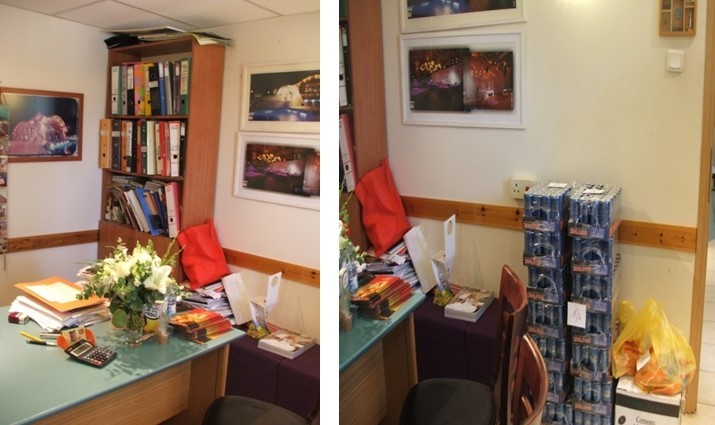
After
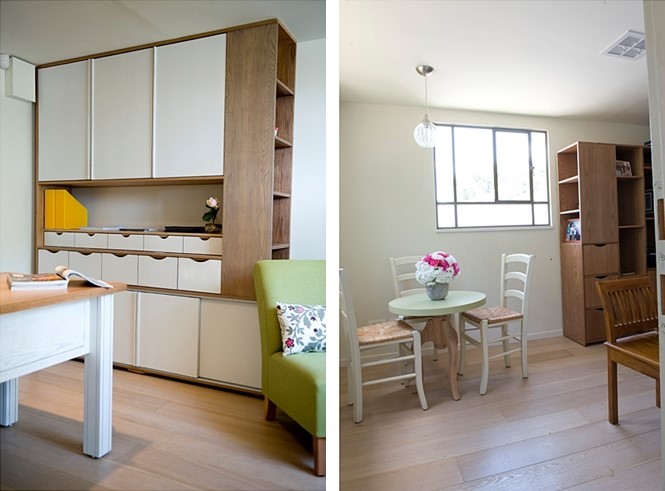
The guiding design principal was the organizational vision – treating business meeting as a guest-hosting experience. Team members wanted to receive clients as hosts and treat them as guests coming to discuss the most important day of their lives. The offices before were far from communicating that feeling.
The waiting room, which looked like a college dorm, was changed both in design and shape – the straight lines of the walls were transformed into curves which hugged clients upon entering. Natural colors and textures were chosen to create a sense of warmth and homeyness.
Before
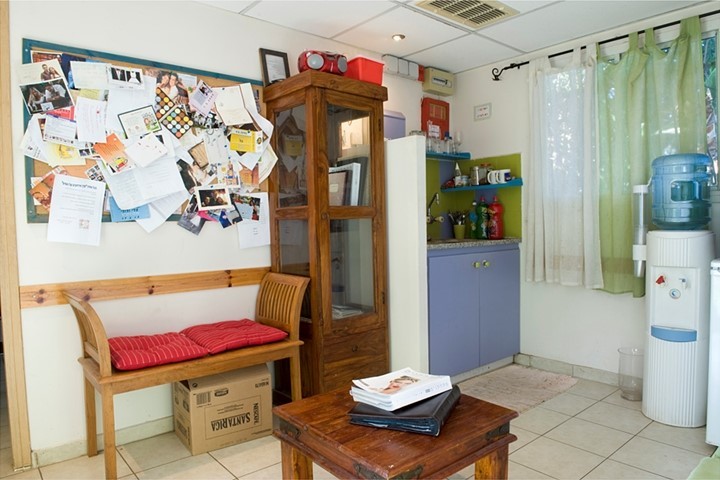
After
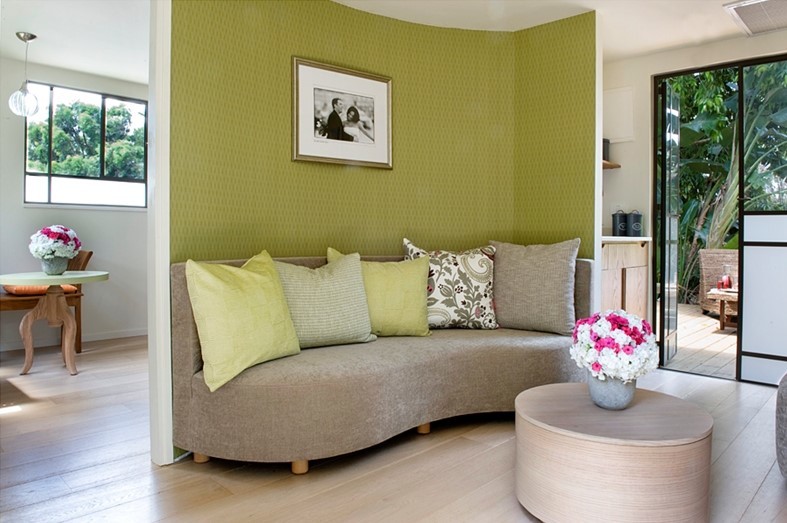
Workstations – before, a desk was the site of meetings with clients, with a salesperson on one side and the client on the other, with the desk separating them. We left desks as workstations only, and designed informal meeting spaces, like a living room, with a round coffee-table.
Outside of the office, we created a space for meeting clients on warm days, by building a deck. Meetings could now take place in a space which encourages "outside the box" thinking. Salespeople became hosts, and clients guests – which was felt by clients, and gave the impression that this venue was the only place which will give them the event of their dreams.
Before
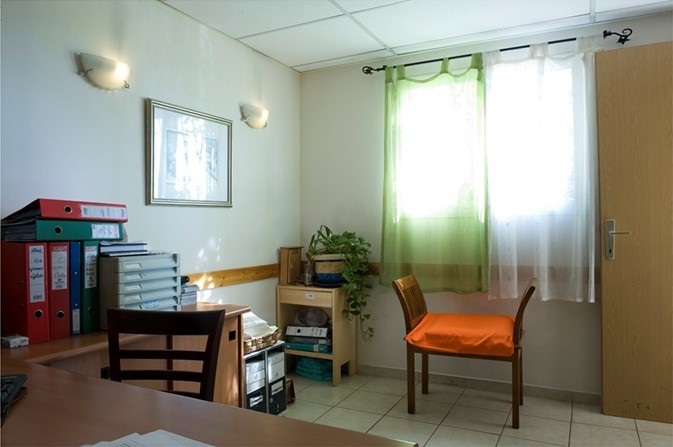
After
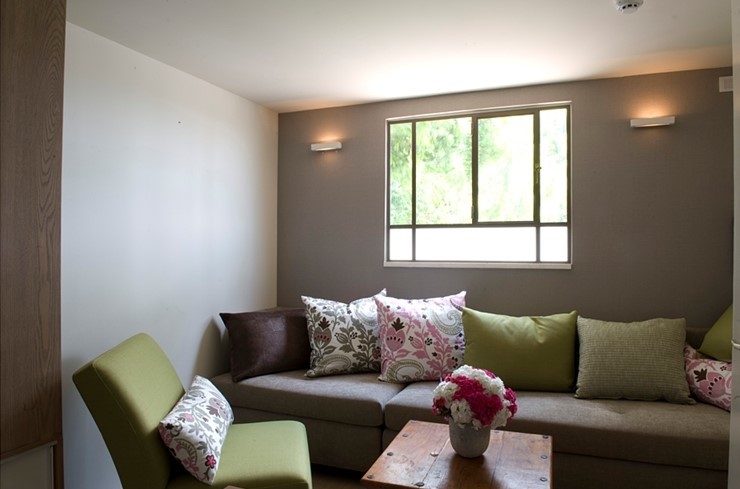
Summary
A natural work environment ensures employees' investment in the company, creates a sense of belonging, loyalty, and enjoyment in the work, increases productivity, and supports good relationships. These create value to the brand, positioning it as unique and competitive – and HR directors should lead an innovative approach in order to leverage the opportunities available to the organization and its employees.
If you are interested in our professional help, personally or for your company, the best way is to send a request through the Get in Touch form in the website (here).








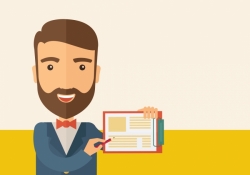



 My First Book: Manage! Best Value Practices for Effective Management
My First Book: Manage! Best Value Practices for Effective Management